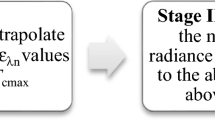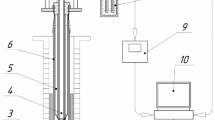Abstract
In this article, we reviewed several existing techniques that were capable of detecting local temperatures in the range of 2000–3500 K in a contact manner. These techniques included several non-standard thermocouples, Seger cones and ultrasonic meters. In particular, ultrasonic meters made of tungsten (W) wires were proven to be working well in nuclear plant for detecting the central temperature of reaction zone. We also presented two alternative approaches. One of them was a kind of single-metal-based thermal sensor made from W, Mo and Ta wires, which utilized the size effect of Seebeck coefficient and theoretically applicable in contact mode measurement up to 3500 K. The other was a kind of detectors with micro-/nano-patterns, which utilized the size effect of surface melting point of bulky materials. This work should shed light on measurement approaches for ultrahigh temperatures in a variety of practical applications.
Graphical abstract










Similar content being viewed by others
References
Fairchild C, Hoover W. Disappearance of the filament and diffraction effects in improved forms of an optical pyrometer1. JOSA. 1923;7(7):543.
Coates P, Lowe D. The Fundamentals of Radiation Thermometers. Boca Raton: CRC Press; 2016. 75.
Morozhenko V. Infrared Radiation. Rijeka: InTech; 2012. 85.
Skorupa W, Schmidt H. Subsecond Annealing of Advanced Materials: Annealing by Lasers, Flash Lamps and Swift Heavy Ions. Cham: Springer; 2013. 211.
Ulanovskiy A, Edler F, Fischer J, Oleynikov P, Zaytsev P, Pokhodun A. Features of high-temperature calibration of W/Re thermocouples. Int J Thermophys. 2015;36(2–3):433.
Ulanovskiy A, Medvedev V, Nenashev S, Sild YA, Matveyev M, Pokhodun A, Oleynikov P. Thermoelectric characteristic of high-temperature thermocouples W5% RE/W20% RE. Int J Thermophys. 2010;31(8–9):1573.
Beerman H. Calibration of pyrometric cones. J Am Ceram Soc. 1956;39(2):47.
Basegio T, Haas C, Pokorny A, Bernardes A, Bergmann C. Production of materials with alumina and ashes from incineration of chromium tanned leather shavings: environmental and technical aspects. J Hazard Mater. 2006;137(2):1156.
Rea RF. Temperature measuring cones. J Am Ceram Soc. 1938;21(3):98.
Kazys R, Zukauskas E, Rekuviene R. Modeling of ultrasonic measurement systems with waveguides. Elektronika ir Elektrotechnika. 2012;123(7):61.
Zhao XH, Wang YR, Chen YZ, Jiang HC, Zhang WL. Enhanced thermoelectric property and stability of NiCr–NiSi thin film thermocouple on superalloy substrate. Rare Met. 2017;36(6):512.
Li G, Wang Z, Mao X, Zhang Y, Huo X, Liu H, Xu S. Real-time two-dimensional mapping of relative local surface temperatures with a thin-film sensor array. Sensors. 2016;16(7):977.
Choi H, Li X. Experimental investigations of laser micromachining of nickel using thin film micro thermocouples. J Manuf Sci Eng. 2008;130(2):021002.
Gregory OJ, You T. Ceramic temperature sensors for harsh environments. IEEE Sens J. 2005;5(5):833.
Chu D, Wong WK, Goodson KE, Pease RFW. Transient temperature measurements of resist heating using nanothermocouples. J Vac Sci Technol B Microelectron Nanometer Struct Process Meas Phenom. 2003;21(6):2985.
Chu D, Bilir DT, Pease RFW, Goodson KE. Submicron thermocouple measurements of electron-beam resist heating. J Vac Sci Technol B Microelectron Nanometer Struct Process Meas Phenom. 2002;20(6):3044.
Chopra K, Bahl S, Randlett M. Thermopower in thin-film copper—constantan couples. J Appl Phys. 1968;39(3):1525.
Justi E, Kohler M, Lautz G. Über die differentielle Thermokraft dünner Metallschichten. Zeitschrift für Naturforschung A. 1951;6(8):456.
Asamoto R, Novak P. Tungsten-rhenium thermocouples for use at high temperatures. Rev Sci Instrum. 1967;38(8):1047.
Bradley D, Matthews K. Measurement of high gas temperatures with fine wire thermocouples. J Mech Eng Sci. 1968;10(4):299.
Wei Y, Wang G, Gao Y, Liu Z, Xu L, Tian M, Yuan D, Ren H, Zhou H, Yang L. A measurement system of high-temperature oxidation environment with ultrasonic Ir0.6Rth0.4 alloy thermometry. Ultrasonics. 2018;89:102.
Laurie M, Magallon D, Rempe J, Wilkins C, Pierre J, Marquié C, Eymery S, Morice R. Ultrasonic high-temperature sensors: past experiments and prospects for future use. Int J Thermophys. 2010;31(8–9):1417.
Carlson G, Plein HG. Refractory metals for ultrasonic thermometry application. 1978;10(9):10448109.
Tasman HA. Nuclear applications of ultrasonic thermometry. In: Proceedings of the Ultrasonics Symposium, New Orleans; 1979. 380.
Lynnworth LC, Carnevale EH, Mcdonough MS, Fam SS. Ultrasonic thermometry for nuclear reactors. Nucl Sci IEEE Trans. 1969;16(1):184.
Arave A, Christensen J, Panisko F. High-temperature ultrasonic thermometer for in-reactor fuel rod centerline temperature measurements. Trans Am Nucl Soc. 1972;15(2):766.
Liu H, Sun W, Xu S. An extremely simple thermocouple made of a single layer of metal. Adv Mater. 2012;24(24):3275.
Huo X, Liu H, Liang Y, Fu M, Sun W, Chen Q, Xu S. a nano-stripe based sensor for temperature measurement at the submicrometer and nano scales. Small. 2014;10(19):3869.
Sun W, Liu H, Gong W, Peng LM, Xu SY. Unexpected size effect in the thermopower of thin-film stripes. J Appl Phys. 2011;110(8):083709.
Szakmany GP, Orlov AO, Bernstein GH, Porod W. Comment on “Unexpected size effect in the thermopower of thin-film stripes”. J Appl Phys. 2014;115(23):236101.
Huo X, Sun W, Liu H, Peng L, Xu S. Response to comment on ‘Unexpected size effect in the thermopower of thin-film stripes’. J Appl Phys. 2014;115(23):236102.
Szakmany GP, Orlov AO, Bernstein GH, Porod W. Single-metal nanoscale thermocouples. IEEE Trans Nanotechnol. 2014;13(6):1234.
Xia Y, Yang P, Sun Y, Wu Y, Mayers B, Gates B, Yin Y, Kim F, Yan H. One-dimensional nanostructures: synthesis, characterization, and applications. Adv Mater. 2003;15(5):353.
Buffat P, Borel JP. Size effect on the melting temperature of gold particles. Phys Rev A. 1976;13(6):2287.
Lai S, Guo J, Petrova V, Ramanath G, Allen L. Size-dependent melting properties of small tin particles: nanocalorimetric measurements. Phys Rev Lett. 1996;77(1):99.
Wang ZL, Petroski JM, Green TC, El-Sayed MA. Shape transformation and surface melting of cubic and tetrahedral platinum nanocrystals. J Phys Chem B. 1998;102(32):6145.
Acknowledgements
This work was financially supported by National Key R&D Program of China (Nos. 2016YFA0200802 and 2017YFA0701302).
Author information
Authors and Affiliations
Corresponding authors
Rights and permissions
About this article
Cite this article
Xu, SY., Wang, ZH. & Gui, LJ. Contact mode thermal sensors for ultrahigh-temperature region of 2000–3500 K. Rare Met. 38, 713–720 (2019). https://doi.org/10.1007/s12598-019-01249-8
Received:
Revised:
Accepted:
Published:
Issue Date:
DOI: https://doi.org/10.1007/s12598-019-01249-8




